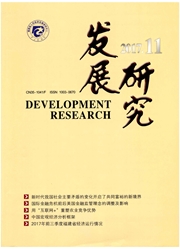

 中文摘要:
中文摘要:
创新驱动是经济发展新常态下中国发展的必然选择。本文选取2000-2014年中国30个省(市、区)的创新能力相关数据构建面板数据集,运用线性加权综合法、变异系数、基尼系数、空间自相关、NICH指数分析等方法,结合GIS空间分析软件和SPSS数据分析软件,探究中国创新能力时空格局演变及其影响因素。研究表明:12000-2014年中国创新能力逐年提升,从2000年的0.199提升至2014年的1.775。其中知识创新能力和技术创新能力提升速度较快,而政府支撑和服务能力以及创新基础环境提升较缓慢。2创新能力区域差异由"大差距低水平"向"小差距高水平"转变,高水平和增长较快的区域主要集中在东部沿海地区,西南和西北各省(市、区)创新能力较弱且增长较慢。3区域物质资本集聚、区域智力资本集聚、区域创新环境、全球化知识溢出等是影响中国创新能力时空格局特征的主要因素。
 英文摘要:
英文摘要:
Supporting national development by innovation is China's inevitable choice in the new normal economic development environment. In this study, the data of innovation capacity of 30 provinces(municipalities, autonomous regions) from 2000 to 2014 were selected to construct panel datasets, and linear weighted synthesis method, coefficient of variation, Gini coefficient, spatial autocorrelation, NICH index, and macro analysis method, combined with GIS spatial analysis and SPSS data analysis tools were used to explore the spatiotemporal change and influencing factors of innovation capacity in China. The results shows that:(1) In2000- 2014, innovation capacity in China increased year by year, from 0.199 in 2000 to 1.775 in 2014.Knowledge innovation capacity and technology innovation capacity improved faster as compared to government support and service capacities and the basic environment of innovation.(2) Difference in regional innovation capacity shifted from great gap at an overall low capacity level to small gap at and overall high capacity level.High capacity and faster growing areas are mainly concentrated in Shanghai, Jiangsu, Zhejiang, Guangzhou, and other eastern coastal provinces(municipalities). Guizhou, Yunnan, Gansu, Xinjiang, Inner Mongolia, and other provinces(municipalities, autonomous regions) in the southwestern and northwestern regions have relatively low level of innovation capacity and slow growth.(3) Regional material wealth concentration, regional intellectual capital agglomeration, regional innovation environment, and global knowledge spillover are the main factors that affect the change of China's innovation capacity. The research results provide some guidance for the improvement of China's innovation capacity and regional sustainable development.
 同期刊论文项目
同期刊论文项目
 同项目期刊论文
同项目期刊论文
 期刊信息
期刊信息
